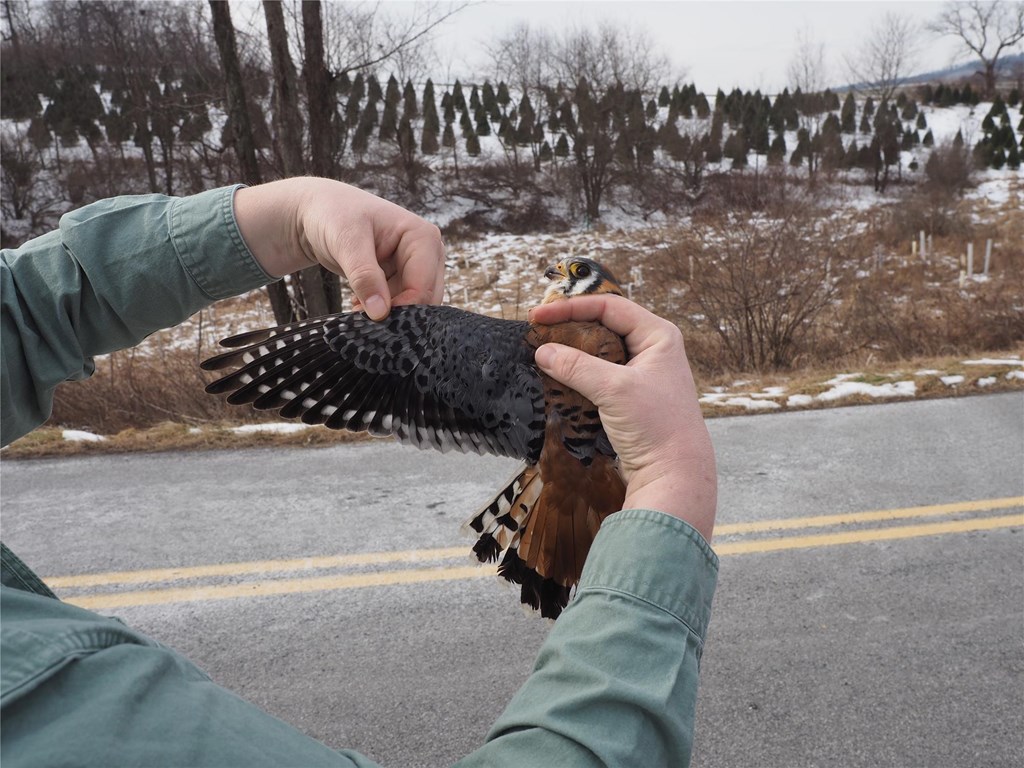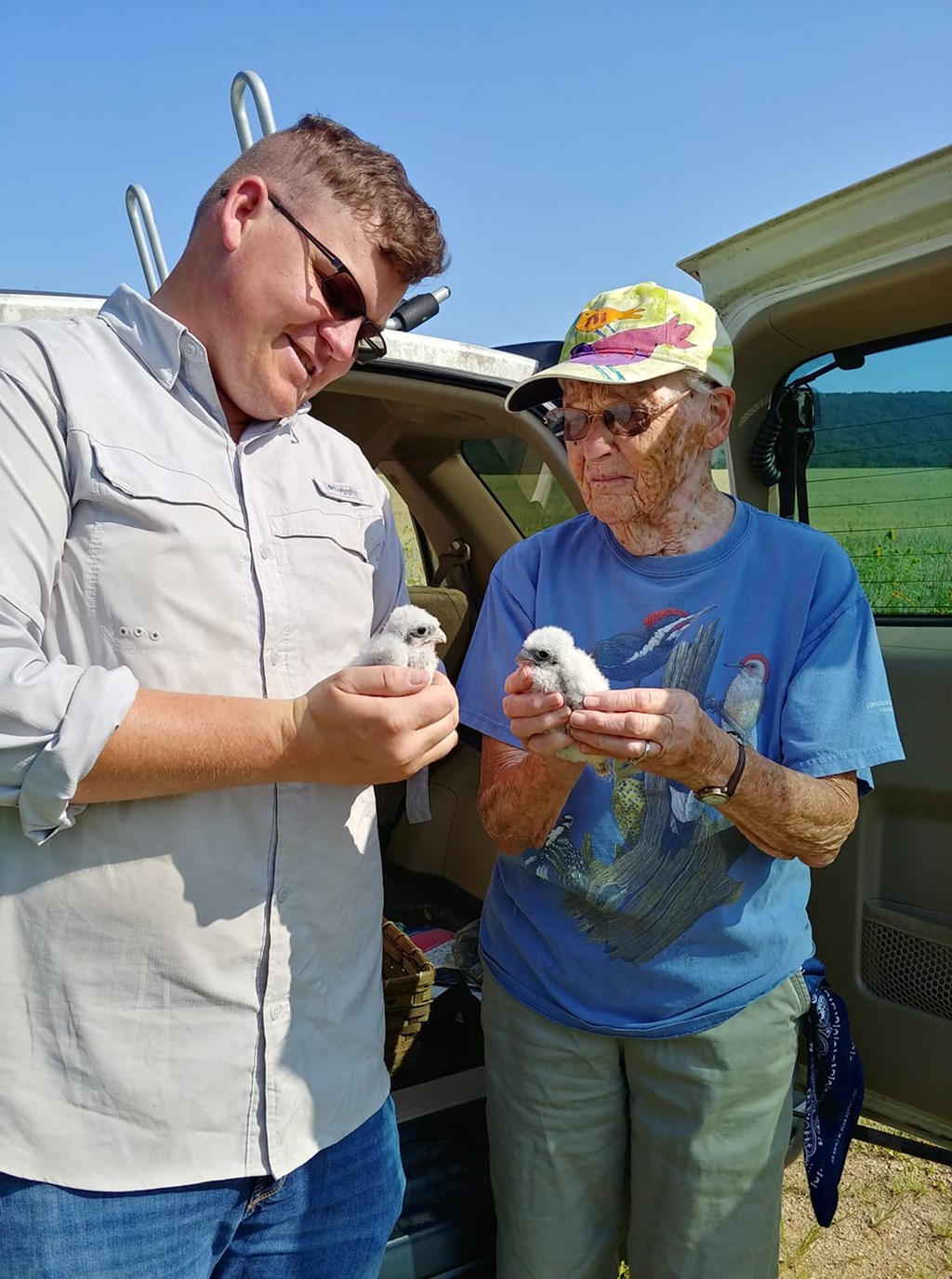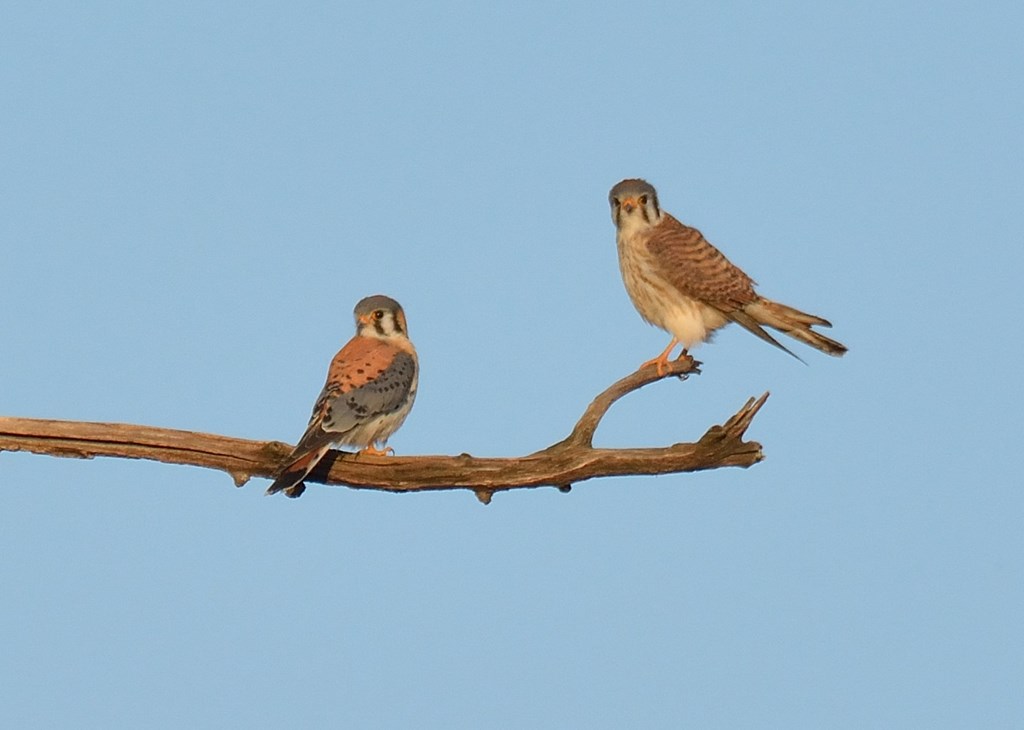Hawk Mountain is Speaking Up for the American Kestrel
Posted on January 29, 2020 in Science

After a record-breaking heat wave in January, Hawk Mountain’s valley was wet and foggy. Last week, Biologist-Naturalist Bracken Brown and Senior Research Biologist David Barber hoped to make use of the morning hours, before the rain arrived and prompted our local farmland raptors to search for cover. The team drove down to the one-lane backroads nestled between quiet farms with charming red and white barns, and Bracken pointed out trees that held Hawk Mountain kestrel nestboxes along our route. The ride continued until we could spot an American kestrel disguising herself with a group of starlings. We placed the trap along the side of the road and backed our vehicle away. Almost immediately the female kestrel swooped down to the trap and danced around it, inspecting it closely. She pecked at it, hovered over it briefly, and then flew back to the safety of her powerline.
She seemed to mock our efforts a few times by bobbing her tail and calling into the fog. Once she resumed her preening, we knew she couldn’t be fooled. After returning from an unsuccessful banding trip, we deduced that the kestrels were likely not hungry enough to fall for our traps due to the unusually warm weather, which would cause slower metabolic functions since body heat regulation would not have been as taxing. Our attempts to trap and band kestrels in the coming weeks will likely be more successful as temperatures return to normal.

Hawk Mountain Sanctuary has conducted long-term monitoring research on American kestrels starting with our migration counts in 1934 and stemming into local nestbox monitoring that began in 1959. Data collected over 61 years has allowed us to monitor local kestrel population trends. The kestrel nestbox monitoring program is the longest running of its kind, and it fosters Hawk Mountain’s community involvement, as our scientists work with local farmers and property owners who have kestrel nestboxes on their properties within the Hawk Mountain viewshed.
However, within the past few years we’ve noticed a downward trend in numbers of kestrel breeding pairs. Hawk migration counts at Hawk Mountain and other eastern sites have shown consistent declines for more than two decades. In response to our observations and thanks to a generous jump-start grant from a family foundation, Hawk Mountain is launching new research to pinpoint the cause for kestrel population declines and ultimately save the kestrel. Funds from the grant will allow us to bring in new graduate students and help leverage additional funding for kestrel research and conservation efforts. Before we can look to the future though, we must look at what we’ve learned from our research in the past.
2019 Results
By evaluating long-term data from our American kestrel nestbox monitoring program, we concluded that 2019 was yet another year of low kestrel breeding pair numbers. Dr. Jean-Francois Therrien, our Senior Scientist who directs the kestrel nestbox research, reported that out of 127 kestrel nestboxes, only 29% were occupied for the second year in a row, housing a total of 35 pairs. Additionally, this year scientists tallied one of the lowest numbers of fledged kestrels ever recorded by Hawk Mountain. Low reproductive success, coupled with the fact that American kestrels have suffered a continental-wide decline over the last 20 years, is cause for concern. Within the last year, we have partneredwith Dr. Allison Cornell and her students from Cedar Crest College to assess the growth and development of the young kestrels by monitoring indicators such as body mass, wing chord, blood content, diet, and parental care at nestboxes.

In closing out 2019 and entering 2020, there has been exciting news that will help us expand our knowledge of American kestrels and further our goal of conserving raptors “while they are still common.” Most of a 77-acre stretch of land adjacent to the State Game Lands at the base of the mountain has been converted to an open meadow of native grassland vegetation. This land was protected by Hawk Mountain and Berks Nature and given to the Pennsylvania Game Commission through a grant from the Conservation Fund and Williams Company. It was transformed into an ideal habitat for grassland raptors like the American kestrel. In the middle of this meadow, Hawk Mountain and the Pennsylvania Game Commission erected a nestbox, which was occupied after only a few weeks. The nesting female was a banded bird, and the pair fledged four chicks: two males and two females. This exciting news shows the benefits of setting aside more land as native grassland habitat. The success of this land conversion has prompted some of the research questions we will pursue in 2020.
So What's Next? Goals for 2020
The new funding will allow Hawk Mountain scientists to pursue pilot kestrel research that will help us to provide answers for the recent decline in kestrels. This grant will also allow Hawk Mountain to fund part of the support for two graduate students and begin a collaboration with an array of kestrel researchers in the east. Our science team and graduate students, led by Dr. Therrien, will be working with a network of scientists in Pennsylvania, New Jersey, Virginia, Florida, and Canada in order to get to the root of the long-term kestrel decline that has caused raptor biologists all along the eastern flyway to scratch their heads. This winter season of kestrel trapping has already started us off on this ambitious journey that we hope to continue for several years.
Kestrel research at Hawk Mountain in 2020 will represent our first steps in pinpointing kestrel declines in the east. One of our goals is to better understand and compare survivorship rates over time and throughout the life cycle. We seek to better understand the cause and timing of the mortality so that steps can be taken in the future to conserve breeding pairs and their nestlings. In order to determine the cause for the decline in fledged kestrels, we must have a better grasp of their developmental processes and survival once they leave the nest. We will be continuing to gather blood samples, feather samples, and unhatched eggs to examine how contaminants such as neonicotinoids and other agricultural pesticides and herbicides may be impacting the birds. We will be utilizing radio transmitters and color bands to further monitor survival of adults and fledglings. Additionally, we will be looking at land use data around nestboxes to measure the impact of land changes on reproductive success and survival.
These projects are exciting and will keep our graduate students and staff very busy throughout the next two years and beyond. Although it will require hard work and further funding, Hawk Mountain will be taking an invaluable first step to gather information that will aid in the conservation of the American kestrel.
To learn how you can support kestrel conservation at Hawk Mountain, contact Mary Linkevich at [email protected] or Laurie Goodrich at [email protected].